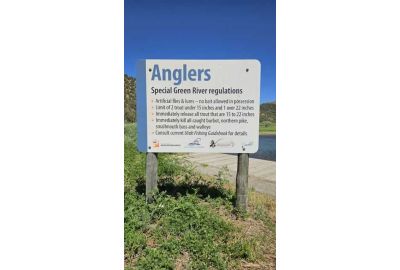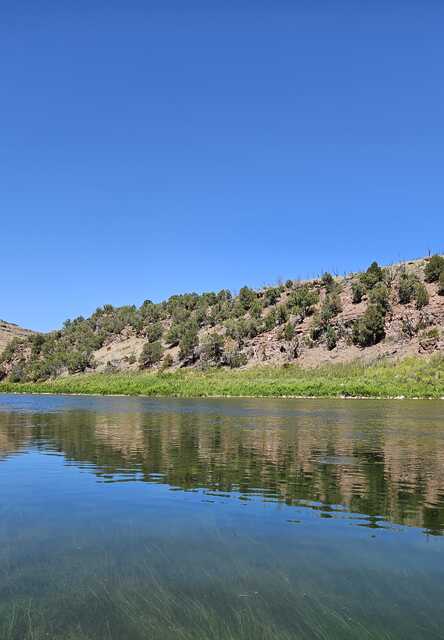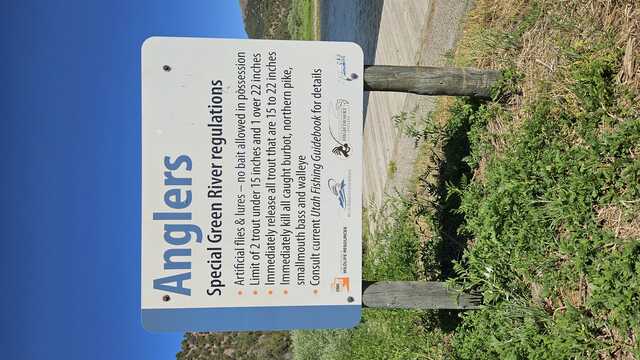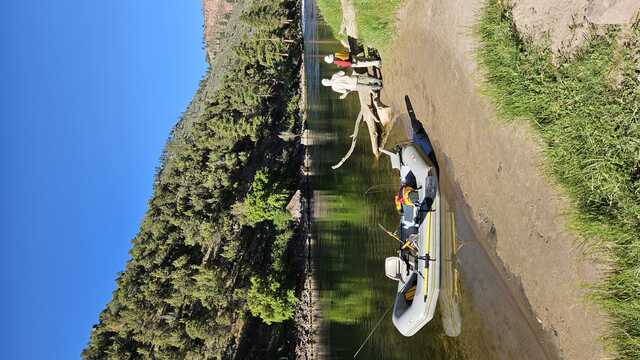I had the opportunity this summer to cross another river off my fly fishing bucket list, the famous Green River below the Flaming Gorge reservoir near Dutch John Utah. The Flaming Gorge dam, located in the northeast corner of Utah, within casting distance of both Wyoming and Colorado, was built in the early 1960’s, creates a reservoir that is an impressive ninety miles long with 350 miles of shoreline. In 1977 alterations were made to the dam outlets to allow water to be released from various depths instead of the original two hundred feet. This provides the river downstream with cool water temperatures, 40 degrees in winter and 54-56 degrees in summer which is perfect for trout. The river is inhabited by Brown Trout that reproduce and are wild and make up about 70% of the population of the fish in the river. Rainbow and Cutthroat trout have been stocked in the river and 25,000 7-inch Rainbows are stocked annually to supplement the natural reproduction. The fishery has thrived and is now under special regulations. Anglers are allowed to only fish with artificial lures or flies and all fish between 13 to 20 inches are to be released, two trout under thirteen inches and one over twenty inches can be kept.
The scenery, especially in the upper sections is spectacular, Red Rock cliffs and rolling hills studded with Pine trees and Sage brush. This section has numerous named spots, such as Lunch Counter, Hog Wallow, Vending Machine and Caddis Wall which all conjure up images of hungry trout. This section sees about 90 percent of the float fishing traffic on the Green River and boasts an estimated 12,000 to 14,000 catchable trout per mile. Once on the water you can immediately see how the river got its name and its nick name, “the Aquarium”, the crystal-clear waters reflect the greenery of the surroundings. Trout are visible everywhere and as you are drifting along you will spot dozens of fish moving away from your boat.
I have been wanting to fish the Green for many years and this July my fishing buddies, Nick and Janice and I made the ten-hour, 660-mile side trip. We fished the Missouri River near Craig Montana for a few days then made the long trip to Dutch John which lies three and a half hours east of Salt Lake City. By booking a year in advance we were able to book accommodations at a house in Dutch John, but accommodations are very limited and a lot of people end up staying in Vernal which is an hour away. We had a guide booked for the first day, always a good idea on the first day on a new river. The river is quite easy to float so the next two days we floated on our own in our Avon raft. One note is that the wearing of life jackets is mandatory on most of the river with the exception of a couple of flat areas.
For the fly fisher the river is “divided” into three sections, Section A (aka Red Canyon) is the dam, which has one boat launch four lanes wide, down to the Little Hole Day use area, which is about 7.2 miles, which is well equipped with three boat launches. Section B goes from Little Hole to the Indian Creek Crossing boat launch, approximately nine miles. Section C goes from Indian Creek Crossing to a boat ramp at Swinging Bridge which is approximately fifteen miles of river. There are several put-in and take outs along this section so doing the whole nine miles is not necessary. The water in this section is warmer and siltier and holds less fish, but also, less anglers.
We paid extra and booked our guide for a longer day so we could float both A and B sections in a single day. We had more luck in Section A, so we decided to float that section on our own both days. We used standard methods, dry fly, nymphs, and dry/dropper, using a hopper a Cicada or a Morman cricket as the dry. The biggest difference in fishing was the way the guide positioned the drift boat. A lot of the float was done sideways with Nick and me facing downstream. We would cast and stop the cast short or pull the rig back upstream and then let it drift down naturally. We caught fish on both the dry and the nymph and it was a surprisingly effective fishing method which allowed both anglers to cover the water effectively. The only drawback was that you must be careful when floating on your own because you do not want to hit anything when floating sideways! We had expected to be seeing and therefore fishing Cicadas, this was the year when they were at their population peak and the Green is famous for its Cicada fishing. While there had been some Cicadas around earlier in the year, we saw very few and our guide said that it had been no better than average fishing their imitations. On the second day when we floated and fished on our own, we stopped at a spot near what is known as Mother-in-Law rapids for lunch. We ended up spending hours casting to and hooking willing Brown Trout. The main hatches happening when we were there were Pale Morning Dun mayflies and Caddisflies, and we had success with imitations of these insects. We also caught many fish on Terrestrials such as grasshoppers, ants, Cicadas and Morman Crickets. While the Brown Trout I have caught in the past have not been know as jumpers when fighting them, these ones certainly are which made for some entertaining fights.


Fishing on foot is very popular and access is gained at any of the boat launches. A maintained path follows the river from the dam all the way to the Little Hole Day use area. This provides shore anglers lots of access from which to fish. When floating remember to always give the shore angler a wide berth as he has worked a lot harder to get there than you have. Keep in mind also that the river is extremely popular with tubers and rafters and can get quite busy on weekends.
The drive to the green was long but well worth it, beautiful trout, beautiful scenery and luckily excellent weather made for a great “bucket list” trip.







